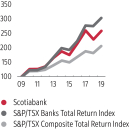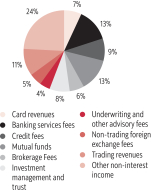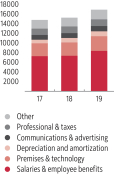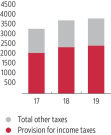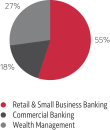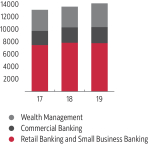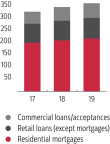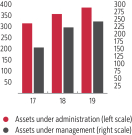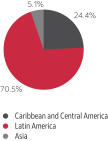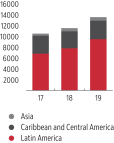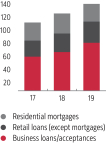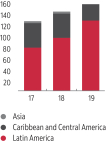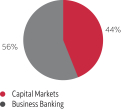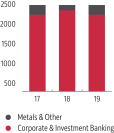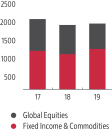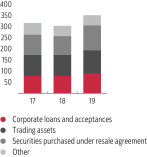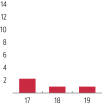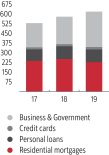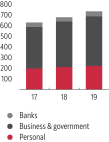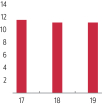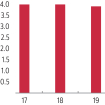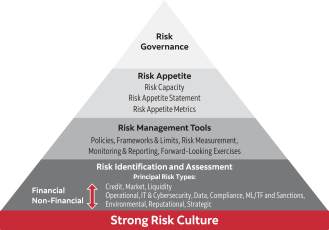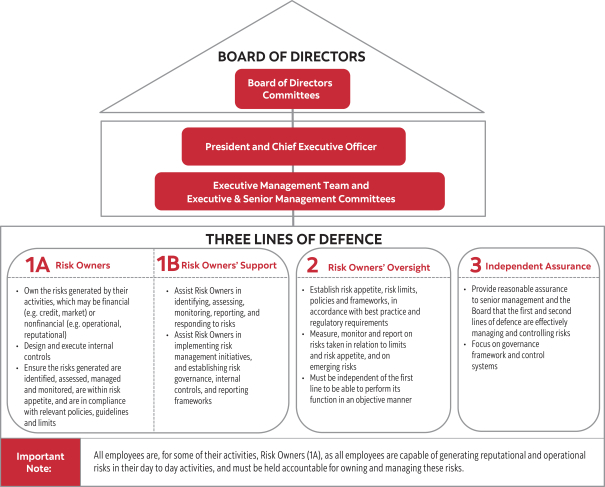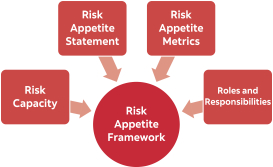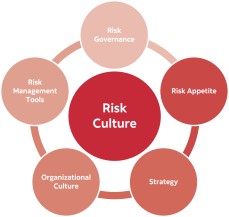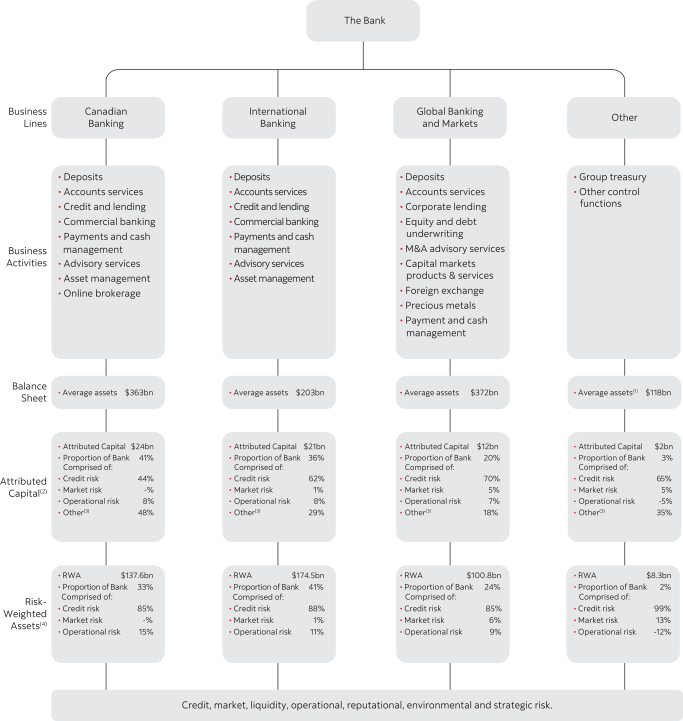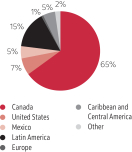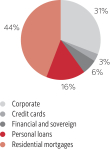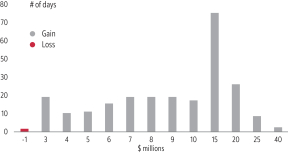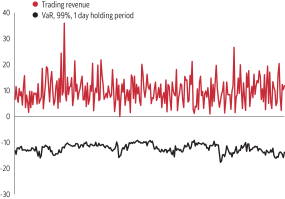Management’s Discussion and Analysis
IG ratings are also used to define credit adjudication authority levels appropriate to the size and risk of each credit application. Lower-rated credits require increasingly more senior management involvement depending upon the aggregate exposure. Where the decision is beyond their authority levels, credit units will refer the request – with its recommendation – to a senior credit committee for adjudication. In certain cases, these must be referred to the Risk Committee of the Board of Directors.
Adjudication
Credit adjudication units within GRM analyze and evaluate all significant credit requests for corporate and commercial credit exposures, to ensure that risks are adequately assessed, properly approved, continually monitored and actively managed. The decision-making process begins with an assessment of the credit risk of the individual borrower or counterparty. Key factors considered in the assessment include:
| • | | The borrower’s management; |
| • | | The borrower’s current and projected financial results and credit statistics; |
| • | | The industry in which the borrower operates; |
Based on this assessment, a risk rating is assigned to the individual borrower or counterparty, using the Bank’s risk rating systems.
A separate risk rating is also assigned at the facility level, taking into consideration additional factors, such as security, seniority of claim, structure, term and any other forms of credit risk mitigation that affect the amount of potential loss in the event of a default of the facility. Security typically takes the form of charges over inventory, receivables, real estate, and operating assets when lending to corporate and commercial borrowers; and cash or treasuries for trading lines such as securities lending, repurchase transactions, and derivatives. The types of acceptable collateral, and related valuation processes are documented in risk management policies and manuals.
Other forms of credit risk mitigation include third party guarantees and, in the case of derivatives facilities, master netting agreements.
Internal borrower and facility risk ratings are assigned when a facility is first authorized, and are promptlyre-evaluated and adjusted, if necessary, as a result of changes to the customer’s financial condition or business prospects.Re-evaluation is an ongoing process, and is done in the context of general economic changes, specific industry prospects, and event risks, such as revised financial projections, interim financial results and extraordinary announcements.
The internal credit risk ratings are also considered as part of the Bank’s adjudication limits, as guidelines for hold levels are tied to different risk ratings. Single borrower limits are much lower for higher risk borrowers than low risk borrowers.
The credit adjudication process also uses a risk-adjusted return on equity profitability model to ensure that the client and transaction structure offers an appropriate return for a given level of risk. For the corporate portfolio, and the large borrowers in International, the Loan Portfolio Management Group reviews the profitability model results, together with external benchmarks, and provides an opinion on the relative return and pricing of each transaction above a minimum threshold.
Individual credit exposures are regularly monitored by both the business line units and GRM for any signs of deterioration. In addition, the business line units and GRM conduct a review and risk analysis of each borrower annually, or more frequently for higher-risk borrowers. If, in the judgement of management, an account requires the expertise of specialists in workouts and restructurings, it will be transferred to a special accounts group for monitoring and resolution.
Credit Risk Mitigation – Collateral/Security
TraditionalNon-Retail Products (e.g. Operating lines of Credit, Term Loans)
Collateral values are accurately identified at the outset and throughout the tenure of a transaction by using standard evaluation methodologies. Collateral valuation estimates are conducted at a frequency that is appropriate to the frequency by which the market value fluctuates, using the collateral type and the borrower risk profile.
In addition, when it is not cost effective to monitor highly volatile collateral (e.g. accounts receivable, inventory), appropriate lending margins are applied to compensate (e.g. accounts receivable are capped at 80% of value, inventory at 50%). The frequency of collateral valuations is also increased when early warning signals of a borrower’s deteriorating financial condition are identified.
Borrowers are required to confirm adherence to covenants including confirmation of collateral values on a periodic basis, which are used by the Bank to provide early warning signals of collateral value deterioration. Periodic inspections of physical collateral are performed where appropriate and where reasonable means of doing so are available.
Bank procedures require verification including certification by banking officers during initial, annual, and periodic reviews, that collateral values/margins/etc. have been assessed and, where necessary, steps have been taken to mitigate any decreased collateral values.
The Bank does not use automated valuation models (AVMs) for valuation purposes for traditionalnon-retail products. GRM performs its own valuations of companies based on various factors such as book value, discounted book value, enterprise value etc.
Commercial/Corporate Real Estate
New or updated appraisals are generally obtained at inception of a new facility, as well as during loan modifications, loan workouts and troubled debt restructure. The primary reason for requiring a new appraisal is if, in the reasonable opinion of the banking execution unit, or GRM, there has been a material change in value. Additionally, none of the appraisal guidelines contained within the policies should dissuade the Bank from requesting an appraisal more frequently if an adverse change in market conditions, sponsorship, credit worthiness, or other underwriting assumptions is realized or expected.
Appraisals must be in writing and must contain sufficient information and analysis to support the Bank’s decision to make the loan. Moreover, in rendering an opinion of the property’s market value, third party appraisers are responsible for establishing the scope of work necessary to develop credible assignment results. The appraisal must meet the regulatory and industry requirements which, depending on the type of property being appraised, contain any or all of the following three approaches to value:
| | i. | comparable sales approach |
| | ii. | replacement cost approach |
82 | 2019 Scotiabank Annual Report

